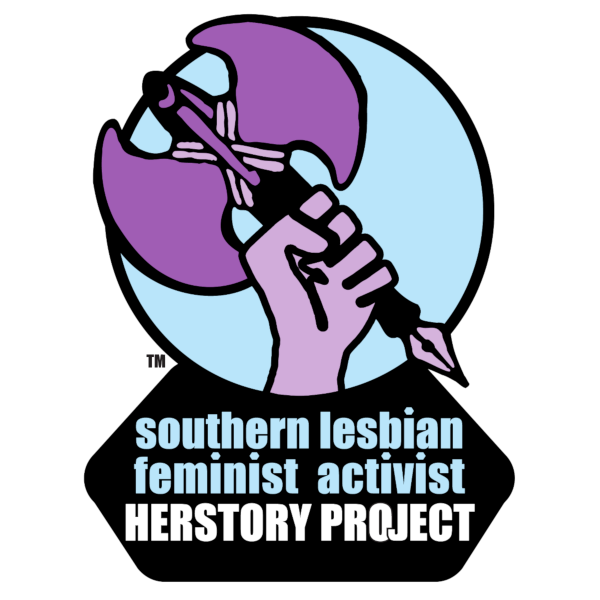About the SLFAHP logo

We chose the labrys, the double ax, best known as the weapon of the Amazon horse culture in the Eurasian Steppe approximately 10,000 years ago, symbolizing the crescent Moon. Remarkable new evidence proves that for millennia before the Amazons, the labrys served as a tool in prehistoric cultures, which were matriarchal, including in Africa, Europe, Asia, and Australia. In the 1970s, with respect to early matriarchies, lesbians embraced the labrys as a symbol of lesbian feminism.
We chose the pen as the handle of our labrys. The pen is the ultimate weapon of power representing our words. In the beginning was the word, the breath, the voice.
We chose the clenched fist holding this pen and labrys to demonstrate our power as women and feminists, with respect to Black power and the recent Black Lives Matter movement.
The hexagon shape that cradles our name, who we are, summons up Pandora’s box. Hexagons on a spiritual level represent the macrocosmic forces, as the planetary or heavenly cosmic forces, and the feminine Divine. The number six represents the feminine Divine. Our name, Southern Lesbian Feminist Activist Herstory Project, is six words.
We chose the colors purple and lavender for their association from Neolithic matriarchal cultures to Sappho. In modern times, these colors symbolize lesbian-feminist activism.
See > Creation of the Logo
See below for more on the symbolism of the elements that compose our logo.
More on the Labrys
The labrys was sacred for millennia before the Amazons. The labrys has been found in prehistoric cultures, which were matriarchal, matrilineal, and egalitarian, engaging peacefully in communal exchanges.
The labrys as the Goddess symbol, sometimes in a stylized form, was used extensively in all of the Mediterranean regions, including northern Africa and the Middle East. The labrys was found as a Goddess symbol in Far Eastern and in Celtic cultures, too.

Labrys as a word likely originated in Crete, the Mediterranean island known to have been populated by farmers from at least 10,000 years ago. The Minoan civilization began on Crete approximately 5,500 years ago. Their culture represents an admirable, modern example of a matriarchal, matrilineal, egalitarian, and multiethnic society. During their peak, Minoans were highly literate, skilled, and enlightened. They were dark-skinned with curly hair and often, with brown eyes. Their civilization tragically declined due to one of the largest volcani eruptions in human history on nearby Thera, which destroyed the Minoan settlement in Akrotiri circa 1,600 BCE. Multiple earthquakes and tsunamis followed over the years. The Minoan culture finally ended circa 1,100 BCE, approximately 3,000 years ago.
The Minoans successfully and peacefully traded with diverse civilizations due to the popularity of their culture and technology. Using their sailing prowess far and wide, their ingenious ships sailed to Africa in routes both by the Mediterranean Sea and by the south Atlantic Ocean. They also sailed to Scandinavia, the Anglo-Celtic Isles, and other islands in the north Atlantic.
Minoans are still studied today as a marvel for their superior engineering achievements on land and sea, as well as for their inventions and architectural innovations, acclaimed as exceedingly ahead of their time. They had an influential, powerful Goddess culture that contributed to their successes. Women were rulers more often than males; and women held high positions in the arts, the trades, and agriculture, as well as holding the chief spiritual positions. In Minoan society, the labrys, often finely crafted of precious gold, was always associated with the Goddess.
Crete contains the recent discovery of fossil footprints of our primary human relatives dating back to almost six million years ago. During the Paleolithic era, more than 130,000 years ago, the first, modern human settlements were there.
More on Purple and Lavender as Symbolic Colors
The purple lotus is sacred in Buddhism. Purple balances the stimulation of red with the calm of blue; and it carries mystical and magical qualities.
From Hinduism, in the seven chakras (the hierarchical energy centers in the body), violet is the color of the crown chakra. It is linked to the crown of the head, the central nervous system, and the brain, the very essence of pure thought connected with the infinite consciousness and deep, spiritual understanding.
From the beginning, the purple lily represented the Goddess as the trinity flower. Naturally, it was prominent and held sacred in many matriarchal cultures, including Egypt.
The violet flower and the color purple were symbols of ancient, matriarchal Athens, associated with Athena, Aphrodite, and Hera. The violet flower even got appropriated by Medieval Christianity as the flower of their new, male trinity, where confusingly, violets at the same time represent the Christian Holy Mother Mary, as do lilies.
On an ancient fragment of a wall painting, discovered in Knossos on Crete, archeologists found purple paints made from lapis lazuli, a very precious stone used to make rare blue pigment, mixed with red ocher and an organic pigment stabilizer to make purple. This is the earliest and most extraordinary, historic example of purple in art, credited to Minoan ingenuity. (This came nearly three thousand years before the discovery of murex purple dye, the garment dye formulated from Mediterranean marine snails.)
Purple and mauve are also in numerous fragments at the Mycenean palace at Pylos. These colors are also found in Mesopotamian cylinder seals at the palace of Thebes. This suggests that with Minoan techniques, by the time of the Late Bronze Age, purple was a favorite color to illustrate the elite and the spiritually powerful.
Furthermore, a wall painting in a throne room in Thera, circa 500 BCE, shows the “Lyre Player” figure, who appears to be a woman wearing traces of purple. Purple emphasized the elevated spiritual status of the wearer. It is known that Sappho, a master musician on the lyre, and the greatest poet who ever lived, liked purple and lavender the most. These colors appear in Sappho’s works to compare the divine feminine to the women she was courting. Lesbians are sometimes called Sapphists, and down through the centuries, Spahhic love has been synonymous lesbian love.
In twentieth-century USA, the Lavender Menace was an informal group of radical, lesbian feminists who were members of the Gay Liberation Front and the National Organization for Women (NOW). On March 15, 1970, feminist Susan Brownmiller had quoted cofounder of NOW, Betty Friedan, on remarks disparaging lesbians as the “lavender menace.” Brownmiller dismissed this as “a lavender herring, perhaps, but no clear and present danger.”
The Lavender Menace protested the exclusion of lesbians and lesbian issues from the feminist movement at the Second Congress to Unite Women in New York City on May 1, 1970. To an uproariously supportive crowd, this protest at the women’s congress in New York City marked a clear turning point in the second-wave feminist movement. It was a founding moment of lesbian feminism. In 1971, NOW adopted a resolution recognizing lesbianism and lesbian rights as “a legitimate concern for feminism.”
“Lavender menace” had started out as a negative term for lesbian feminists, who reclaimed it. Ever since, lavender and purple became our colors.
More on the Hexagon
The hexagon, defined as any six-sided shape, is the strongest, basic shape in Nature, like snowflakes and beehive honeycombs. The hexagonal cells of a beehive honeycomb make efficient use of space and require less building material for strength and security. Even when compressed, this shape stays firm.
Many types of hard crystals are formed from hexagons: quartz, dolomite, beryl, tourmaline, calcite, bismuth, etc. Rare hexagonal diamonds are harder and tougher than regular diamonds, which are the hardest known natural matter.
Carbon, the sixth chemical element that is the basis of all life, has an atomic weight of 6. In hexagon formation, carbon becomes graphite, one of the softest substances. When carbon forms the hexagonal crystal shape, it’s the hardest, naturally-occurring substance: a hexagonal diamond. Carbon mixes with other substances to form almost ten million different compounds. The carbon-nitrogen cycle provides some of the energy produced by the Sun and other stars.
The geodesic dome, re-invented in the twentieth century and based on the hexagon, provides the most sturdy and durable form of building, offering protection from hurricanes, tornadoes, and even earthquakes to a degree.
The original trinity was the Goddess as the Maiden, the Mother, and the Crone. Thus, the primordial meaning of six is a congregation of women. One triangle placed atop another, as in the six-pointed star, denotes matriarchy since ancient times.
~Jeanine DrJazz Normand

